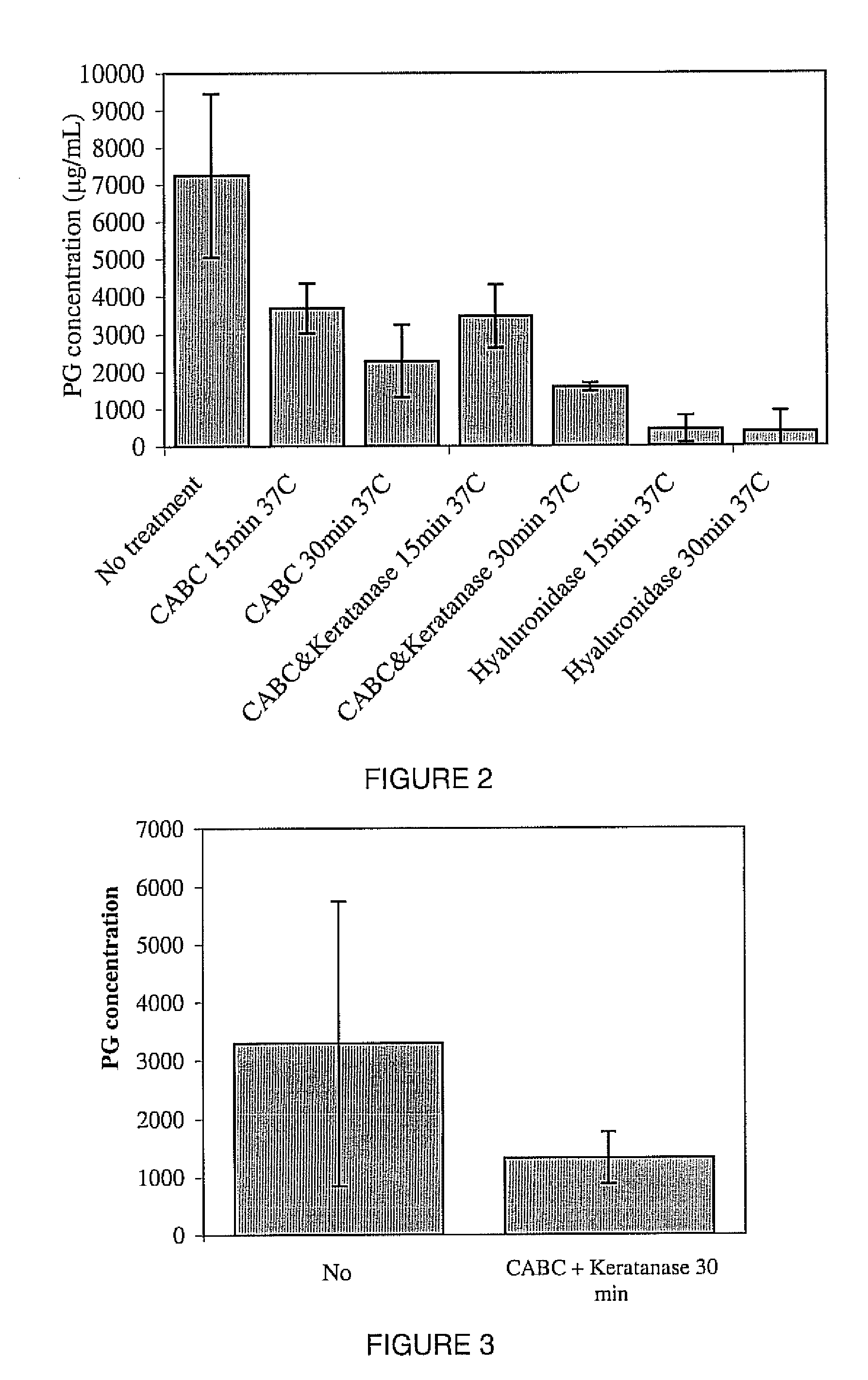Tissue transplantation compositions and methods
a composition and tissue technology, applied in the field of tissue transplantation compositions and methods, can solve the problems of less effective control of vertebral motion by redundant annular fibers, less limited healing properties of connective tissues, etc., and achieve the effect of increasing the volume of the intervertebral disc structur
- Summary
- Abstract
- Description
- Claims
- Application Information
AI Technical Summary
Benefits of technology
Problems solved by technology
Method used
Image
Examples
example 1
[0121] The nucleus pulposus (NP) and annulus fibrosus (AF) of goat intervertebral discs (IVDs) were separated and cut into 1-2 mm diameter pieces using surgical micro scissors. 25-100 microliter samples of NP or AF were placed into micro centrifuge tubes, and 0.8 ml of enzyme solution was added to each of these tubes. Six conditions were analyzed: solutions of 0.10 units / ml Chondroitinase-ABC, 0.10 units / ml Chondroitinase-ABC+0.10 units / ml Keratanase, or 3500 units / ml Hyaluronidase were added to the IVD samples for 15 minute and 30 minute time periods. After digestion, proteoglycan (PG) was extracted using 1 ml of 4 M Guanidine Hydrochloride (GuHCl) overnight. Alcian Blue was added to the PGs. Then PG-Alcian Blue was precipitated and centrifuged. The PG-Alcian Blue pellet was dissolved and the absorbance of the final solution was read at 620 nm using a spectrophotometer. The assay quantified only the sulfated PGs; Hyaluronan was not quantified. Chondriotin-6 sulfate with varying con...
example 2
[0124] The Nucleus Pulposus (NP) and Anulus Fibrosus (AF) of human intervertebral discs (IVDs) were separated and cut into 1-2 diameter particles using micro surgical scissors. The IVD particles were treated with enzymes, GuHCl, and Alcian Blue as described in Example 1. FIG. 3 shows the results of the treatment of these human IVD particles with CABC+Keratanase for 30 minutes
[0125] 50,000 human mesenchymal stems (MSCs) / sample were added to the NP particles treated with enzymes CABC+Keratanase for 30 minutes, and grown in 1.804 mg / ml collagen gel. The cells and digested particles were incubated at 37° C. for 30 minutes, and then forced through a 16 GA needle. The cells and particles were then cultured for 48 hours after being forced through the needle. Analysis indicated that only a small number of cells, less than 10%, died.
example 3
[0126] Digested and Non-digested (Control) NP particles were placed into 15 ml centrifuge tubes, and one million MSCs were added to each tube. On day one the medium comprised of 0.5 ml DMEM with 10% FBS, 1% Penicillin Streptomycin, and 0.1% Amphotericin B. The NP particles, cells, and medium were centrifuged for 10 minutes at 3000 rpm and 37° C. The caps of the centrifuge tubes were slightly opened to allow oxygen flow, and the pellets were kept in an incubator. The medium, 0.5 ml DMEM with 10% FBS, 1% Penicillin Streptomycin, 0.1% Amphotericin B, and 10 ng / ml of TGF-Beta 1, was changed every two days. In order to determine PG content, at day 14 the pellet was washed with PBS and the tubes were vortexed to break down the pellet using GuHcl as described in example 1. PG content was determined with Alcian Blue assay also as described in example. In order to determine cell count, the pellet was washed with PBS and 0.5 ml medium without TGF-Beta 1 was added on day 14. The tubes were vor...
PUM
| Property | Measurement | Unit |
|---|---|---|
| Fraction | aaaaa | aaaaa |
| Volume | aaaaa | aaaaa |
| Particle size | aaaaa | aaaaa |
Abstract
Description
Claims
Application Information
 Login to View More
Login to View More - R&D
- Intellectual Property
- Life Sciences
- Materials
- Tech Scout
- Unparalleled Data Quality
- Higher Quality Content
- 60% Fewer Hallucinations
Browse by: Latest US Patents, China's latest patents, Technical Efficacy Thesaurus, Application Domain, Technology Topic, Popular Technical Reports.
© 2025 PatSnap. All rights reserved.Legal|Privacy policy|Modern Slavery Act Transparency Statement|Sitemap|About US| Contact US: help@patsnap.com


